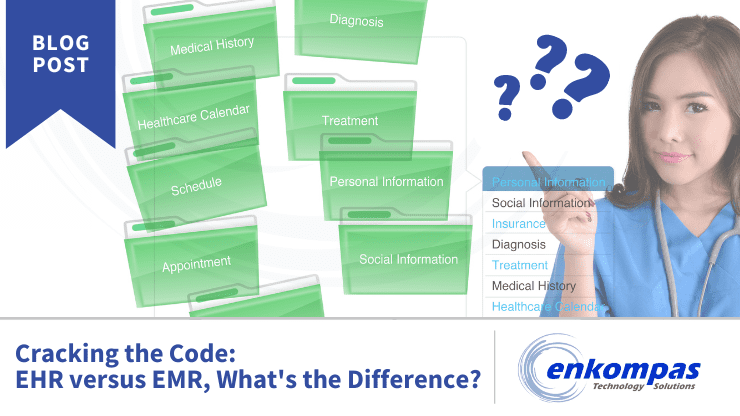In healthcare technology, the acronyms EHR and EMR play central roles. The two shortcuts for Electronic Health Record and Electronic Medical Record, respectively, can also play a confounding role. The terms often leave people confused about whether they are the same or different types of records. Although they are related yet distinct terms, the lines between EHRs and EMRs have blurred considerably. Let’s unravel the nuances and understand why these terms are now typically used interchangeably.
What Is an EMR (Electronic Medical Record)?
Electronic Medical Records (EMRs) focus primarily on the clinical aspects of patient care within a single healthcare organization or practice. EMRs typically contain medical and treatment histories, diagnoses, medications, and test results generated by healthcare providers within that specific facility. While EMRs serve as digital versions of traditional paper charts, they’re limited to the scope of a single provider.
What is an EHR (Electronic Health Record)?
On the other hand, Electronic Health Records (EHRs) represent a comprehensive digital repository of a patient’s medical history. EHRs include treatment plans, diagnoses, medications, allergies, laboratory test results, and more. They’re designed to include data from all healthcare providers involved in a patient’s care. This enables seamless information exchange across different healthcare settings. EHRs offer a holistic view of a patient’s health status, promoting coordinated and patient-centered care delivery.
Experience Growth in Your Company Through EHR Optimization
The EHR/EMR Interchangeability Conundrum
Strictly speaking, an Electronic Medical Record is limited in scope to a single healthcare provider. And an Electronic Health Record integrates data from multiple providers to create a more holistic patient health record. That is, an EHR can follow the patient across practices or facilities. EHRs enable data sharing and care coordination among different healthcare teams. EMRs are traditionally practice-centric, keeping the data “stuck” in one medical office or practice.
However, in recent years, the distinction between EHRs and EMRs has become increasingly murky, leading to widespread usage of these terms interchangeably. Technological advancements and interoperability initiatives have propelled EHR systems to encompass functionalities traditionally associated with EMRs, such as clinical documentation, order entry, and decision support tools. Similarly, EMR systems have evolved to incorporate features facilitating data exchange and interoperability with external healthcare entities, resembling the broader capabilities of EHRs.
How Did We End Up with EMRs and EHRs in the First Place?
As the world became increasingly digitized, widespread implementation of basic EMR systems first took hold in the 1990s. Again, these EMR systems were electronic records limited to a single practice. Over the ensuing two-plus decades, there has been a gradual shift to the use of EHRs, which was driven by several factors.
Somewhat surprisingly, the story of EMRs and EHRs starts several decades earlier. Here’s a very basic timeline on the use of electronic records in healthcare.
The 1960s and ‘70s
This is going to blow your mind: The very first EMR/EHR systems not only go all the way back to the 1960s, but they were also originally called “clinical information systems.” Lockheed developed one of the first of these systems, which heavily influenced later systems. In fact, the original product was passed along through several different healthcare systems between then and now. Evolving with technology over the past half century, that early Lockheed system is now a part of Allscripts!
In the 1970s, the federal government began using an Electronic Health Record within the Department of Veteran Affairs.
The 1980s
In the 1980s, leaders recognized benefits that would accrue by adopting industry-wide standards. Organizations began to form to figure out how to facilitate the widespread use of electronic medical information. In 1987, Health Level 7 (HL7), an international, nonprofits standards-developing (SDO) was formed.
The 1990s – Early EMR Adoption
Many healthcare organizations started implementing basic Electronic Medical Record systems in the 1990s to digitize patient records within their practice. These were limited to a single facility/provider.
The Early 2000s – EHR Development
The concept of Electronic Health Records, which could integrate data across multiple providers, began to pick up speed in the early 2000s. International, technical standards like Health Level 7 (HL7) – a protocol for exchange of healthcare data – were developed to enable interoperability. These frameworks defined the structure of interoperable EHRs that were distinct from EMRs.
2004 – The Establishment of the ONC
The Office of the National Coordinator for Health Information Technology (ONC) was established in 2004 to coordinate EHR adoption efforts across the United States.
2009 – EHR Definitions and the HITECH Act
In 2009, the ONC defined “Certified EHR Technology,” which had to include capabilities such as patient demographics, clinical data, order entry, and interoperability to qualify for incentives from the federal government. The Health Information Technology for Economic and Clinical Health (HITECH) Act, under the American Recovery and Reinvestment Act of 2009, provided those financial incentives to providers that adopted certified EHR technology.
Around this same time, The Healthcare Information and Management Systems Society (HIMSS) defined and Electronic Health Record as, “a longitudinal electronic record of patient health information generated by one or more encounters in any care setting.”
The 2010s – Meaningful Use
Launched in 2011, The Meaningful Use incentive program prompted many providers to adopt certified EHR systems which met data sharing and interoperability standards. Created by the Centers for Medicare and Medicaid Services (CMS), this EHR Incentive Program established the specific objectives EHRs needed to meet to facilitate care coordination and to exchange healthcare information across providers.
EHRs Versus EMRs – The Bottom Line
While historically EHRs and EMRs served distinct purposes, the evolution of healthcare technology has converged their functionalities significantly. Over the last few years, conversations about the healthcare industry increasingly use the terms “EHR” and “EMR” synonymously, reflecting the comprehensive nature of modern electronic health records systems. Whether you call it an EHR or an EMR, the overarching goals remain the same: leveraging technology to enhance patient care, streamline workflows, and improve healthcare outcomes.
That is, both healthcare providers and their patients accrue benefits from having comprehensive, portable, and interoperable records. As a result, most practices delivering physical medicine have now implemented an EHR due to those benefits, and other Health and Human Services agencies are starting to follow suit.
About enkompas Technology Solutions
enkompas powers your entire technology environment, working closely with your team to provide strategic enterprise technology solutions. With nearly 30 years of experience as a trusted managed IT services partner, our goal is to help you build a secure, scalable organizational roadmap. Contact us for more information on how enkompas Technology Solutions can help your organization select an EHR, achieve EHR implementation success, and support your secure tech environment with our subject matter expertise and proven Organizational Change Management Blueprint.


